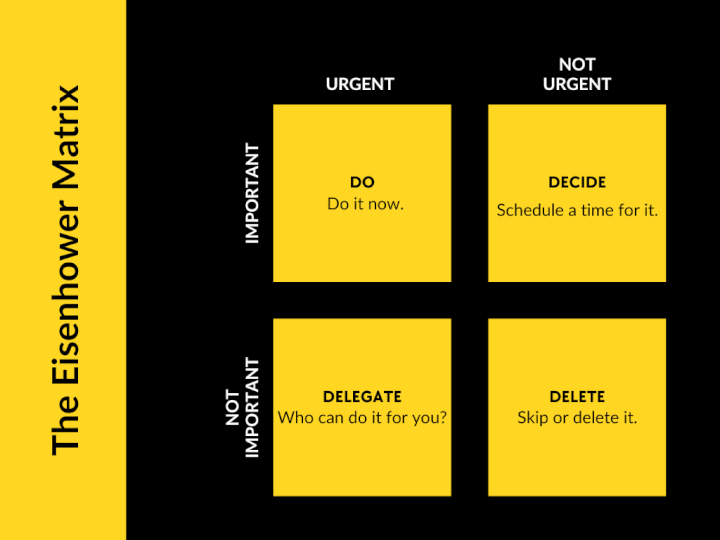Whether your work environment is an office, hybrid, or fully remote, the struggle of managing all your tasks efficiently is a struggle we can all identify with. Without effective time management, your days can often end with tasks piling up, leaving you feeling overwhelmed and frustrated. While many tips on how to improve time management are available with the rise of remote work, they're mostly vague, non-specific, and don’t help you develop a sustainable routine that will improve long-term productivity.
What is time management, though? Unlike what many seem to think, time management is more than reducing distractions and doing as much work as possible. It is a process that involves planning, prioritization, and goal setting. Those who practice efficient time management are mindful of how they spend their time and set healthy boundaries.
Here are 3 highlights from our Time Management and Productivity course that will transform your approach to your tasks.
1. Goal setting
There are three major types of goals: long-term, medium-term, and short-term. Being able to categorize each of them is essential to being able to accomplish them.
Short-term goals are the tasks that can be completed within a few weeks, if not days. These steps in a marathon get you started and are absolutely necessary throughout the race. However, moving your feet won’t ensure you cross the finish line.
Medium-term goals are often set for a few months in the future, but occasionally they stretch into a few years. This might look like aiming for a raise or renovating your home. These goals are the key to linking your everyday tasks to achieving your long-term goals. During a race, marathon runners must also be consistent with their breathing techniques and deliberate with their water intake. This makes the little steps worth it and crossing the finish line easier.
Long-term goals are more big-picture and usually consist of many other smaller goals. This could be starting a business or retirement in Florida. Either way, they set the tone for all your other goals and work as a base with which to align and prioritize all your endevours. A marathon's aim greatly affects how a runner uses the previously mentioned techniques. In a competitive marathon, runners adjust their strategies to win and prioritize maintaining speed. In a charity marathon, this changes to methods that ensure completion.
Categorizing your goals is one of the best ways to begin changing your productivity habits. 
2. Strategies to maximize productivity
Sometimes the most challenging aspect of productivity is getting started on a task. There are some methods, however, that have been proven to be incredibly effective when done right.
Time-blocking is regulating specific tasks to specific times in the day. For example, ease yourself into work by starting the first 30 minutes of the day by simply checking emails and messages, having lunch at a specific time, and limiting meetings to certain periods of time when possible. Using this method, you can avoid the stress of not knowing what to tackle first and improve concentration. For this method to be most effective, however, creating your schedule in advance is necessary.
Another great tool is the 2-Minute Rule. This Rule says that if a task can be done in 2 minutes or less, you should do it immediately. That way, small task buildup is avoided, you can build and maintain momentum throughout the day, and you are left with larger blocks of uninterrupted time to complete larger, more complex tasks.
Learn more about course instructor Dan Gorgone’s time maximization strategies in the following video.
3. The art of saying “No”
Remember, productivity isn’t cramming as many tasks as possible in a limited period of time. Those who take that approach often find themselves burnt out and left feeling unaccomplished. Mastering time management usually means mastering how to say no to tasks that will likely affect the quality to which you complete the tasks you are already working towards. Here are some questions you can ask yourself to evaluate the value of a request:
- Does the task align with my goals and priorities?
The long-term goals mentioned earlier are crucial to assessing the value of a potential task. Everyone has gotten distracted by a passion project now and again. Still, by evaluating its immediate importance to you and your goals, you will be able to prioritize it appropriately and even potentially decline it until a later time.
- Will taking on this task disrupt more important tasks?
Often overlooked is the evaluation of the possible resource displacement in taking on additional tasks. This includes time, effort, and money that would need to be allocated to the new task that would have been spent on more important ongoing projects. While at times, the displacement is minor and can easily be rectified other times, you could save time and effort to complete the more pressing matter.
- Do I realistically have the capacity to complete the task, given my current workload?
A task may align with your goals and require resources that you can afford to spare without making any significant sacrifices, but you just don’t have the time. It’s ok to decline. When so much of our work can be done on the computer, it can be tempting to accommodate extra tasks by working extra hours. However, research has shown the negative physical and mental effects of those midnight emails and Slack messages. Knowing your limits and letting them be known is vital to long-term time management and maximizing productivity.
That being said, sometimes the hardest part is just saying no. The video below gives some great tips on the art of saying no.
Conclusion
Changing your habits to boost productivity involves more than just trying a trick for a day. It has more to do with changing your perspective and how you approach your work so that your various tasks no longer seem like many individual hurdles to cross but are more like building blocks to creating your personal pyramids! Each placement must be deliberate and done with consideration in the best way possible.
Learn how to create and implement a system of organization and prioritizing that works for you by taking the full Time Management and Productivity Course.
Want to be more productive?
Start learning for free with GoSkills courses
Start free trial



